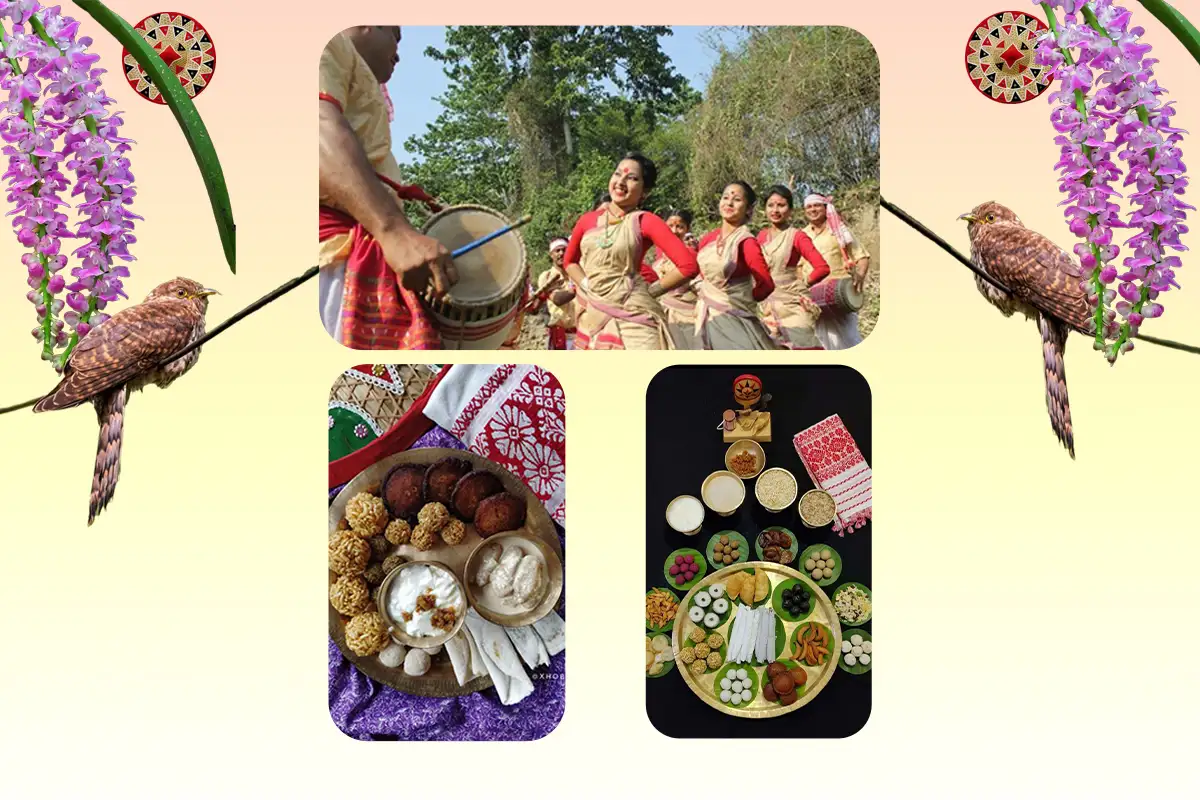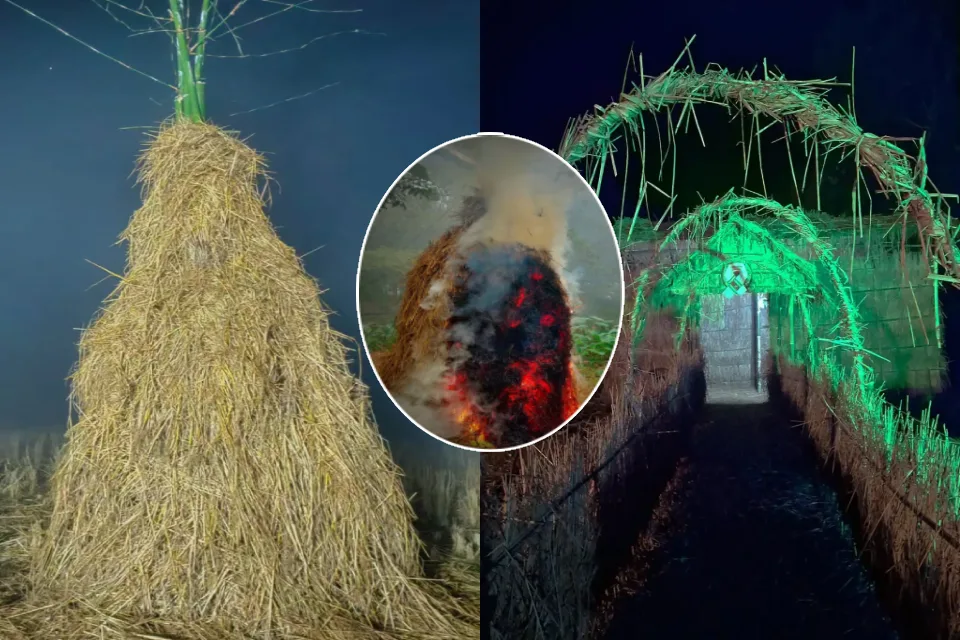Let’s explore the seasonal influence on Assamese Bohag Bihu, its significance in Assamese culture, and how the month of April keeps Assamese people enthusiastic.
Updated on :
Share this post
Assamese Bohag Bihu is a popular festival of Assam that signifies the start of the spring season and the Assamese New Year. It is also called Rongali Bihu because of its wonderful vibrancy (Rong—The Colors). The arrival of spring and seasonal changes are strongly linked to its celebrations and festivities.

The celebration of any agrarian tradition or festival is primarily focused on the agricultural and natural environments, as well as the sociocultural and religious characteristics of the populace.
The three Bihu festivals have different customs and celebrations that are perfectly suited to the three seasons during which they are observed. Bohag Bihu is a special festival of customs and traditions celebrated to welcome the Assamese new year and the joy of spring.
Let’s explore more on Assamese Bohag Bihu
Seasonal magnitude of Bohag Bihu
In the state, Assamese Bohag Bihu marks the arrival of spring. This season, known as Rituraj (best season) in Assamese, is named Basanta Ritu. Basanta means spring, and Ritu means season. A wonderful festive atmosphere results from the state’s natural beauty becoming magnificent during this time of year.
This time of year, the weather is pleasant as well—it’s neither too hot nor too cold. Around the event, pre-monsoon rain begins in the state and typically results in strong downpours. The rainstorms that take place during the Assamese Bohag Bihu period are known as Bordoisila.
Flora and fauna during Assamese Bohag Bihu
Throughout the season of Assamese Bohag Bihu, nature’s breathtaking scenery is transformed by all the sights. Every type of plant, including trees, shrubs, and herbs, produces new leaves, and many of them bloom with lovely flowers of all hues and forms. The season also sees the bloom of several rare and exquisite orchid species.
A lot of the season’s flowers have the best scents and enchant the atmosphere. With so much food and prey available, the abundant fauna in the hills and rainforest begins to grow stronger. Patches of flowers of different colors make the Green Hills greener and more spectacular.
It is also fish spawning season, and a wide variety of fish can be seen displaying their erratic behavior in various water sources, such as rivers, streams, and marshy areas.
Migratory birds and their significance
“Rati Baroh Bojat kuli ketekiye janoni dile he aaita, bohagi palehi”
During Assamese Bohag Bihu, various migrating bird species visit this region of the world, and at any time of day or night, people often spontaneously appreciate their melodic song. These migratory birds migrate for the exact reason that it is their breeding season.
The Assamese Bohag Bihu is remarkable for two birds—Keteki-sorai (hawk-cuckoo) and Kuli-sorai (koel). When Assamese Bohag Bihu arrives, the kuli sorai begin to sing in a melodic manner, wonderfully entrancing the surroundings. Thus, it is stated that Bohag Bihu arrives with the singing of a kuli sorai. The male Kuli Sorai sings to attract females and to notify its position during the breeding season. After a few days of kuli, Keteki Sorai begins to sing.
Blooming flowers and orchids of April
“Nahor phul phulile madhoi maloti, kopou phul phulile madhoi maloti
Phulile keteki, togor oi maloti, kuli xuror dhwoni keteki binoni “
Kopouphul, the Assamese name for the foxtail orchid, has a unique meaning in Assamese Bohag Bihu. The foxtail orchid blooms at the time of Bohag Bihu in the nature of Assam. It is currently grown in the gardens of a few Assamese homes. When performing the Bihu dance and during the festival, Assamese ladies use Kopouphul to adorn their hair. For an Assamese girl, it is a special token of love.
For hair adornment, women also favor two more kinds of flowers, particularly in Assamese Bohag Bihu. In particular, they are Indian rose chestnut (Nahor phul) and wax flower (Togor phul). Kewda (Keteki phul) is another flower that is significant to Bohag Bihu. This marvelously aromatic flower blooms in nature.
Significance of Mahavisuva Sankranti
Currently, the three Bihu festivals are observed on the dates of three distinct Sankranti in the Assamese calendar. Mahavisuva Sankranti is the time for celebrating Assamese Bohag Bihu. Another name for it is Mesha Sankranti. The sun enters Mesha Rashi, or sidereal Aries, on this day.
Since it marks the start of the solar calendar, the day is celebrated as the new year among the majority of Indian states and races. The sun shifts to the north after Mahavisuva Sankranti. As a result, the day the sun moves northward for the first time is considered the New Year. This day is regarded as auspicious nationwide and is celebrated with religious and socio-cultural performances.
7-day rituals of Assamese Bohag Bihu
Assamese Bohag Bihu is also called “Xaat Bihu because of its 7-day festivities. The rituals of the festival are performed systematically for seven days, and each day is named according to the type of mandatory ritual to be performed. Let’s have a deep look into the significance of each day.
Day 1: Goru Bihu
This first day of Assamese Bohag Bihu is mostly for the purpose of washing and taking care of cows and bullocks. Cattle are deeply loved and respected in Assamese society because of the state’s rich agrarian tradition. A variety of black gram and turmeric pastes, oil, and a tool called a chaat (a thin bamboo stick with vegetable slices fastened into it) are prepared by people.
Following that, the male members take their cattle and preparations to a nearby water source. After rubbing the pastes on them, the cows and bullocks are cleaned. Certain tribes also decorate them with clothing and flowers. In addition to feeding the cows, the vegetable slices are tossed on them with the hope of their prosperity and well-being.
Back home, the remaining vegetable slices are cooked into a curry that has therapeutic properties. The family members bathe with the same paste on the day of Goru Bihu, tie the cows with fresh ropes, and participate in traditional performances known as Husori in the evening.
Day 2: Manuh Bihu
Manuh Bihu is one of the most important days of Assamese Bohag Bihu. It is dedicated to the people. Manuh Bihu is celebrated with a variety of ceremonies aimed at personal well-being, family welfare, healthy interpersonal connections, and sociocultural growth.
The day starts with a medicinal bath by applying a traditional paste of therapeutic value, followed by offering prayers to God. Traditionally, during prayer, a Guwapan or Tamulpan (areca nuts and beetle leaves) is offered in an Xorai to honor the senior. In addition, a Bihuwan (kind of Gamusa) and a Seleng-sadar are given. The senior members, in return, offer blessings.
Receiving blessings from the mothers is one of the distinctive and high-value rituals of Bohag Bihu. Gifts and affection are given to siblings, spouses, lovers, and close family members. Some of the therapeutic practices performed are eating some bitter foodstuff on an empty stomach and inhaling steam of Lai-jabori (Drymaria cordata).
Day 3: Kutum Bihu
On Kutum Bihu, individuals pay visits to their close relatives. A married daughter, together with her husband and children, pays a visit to her parents’ home. Special traditional delicacies are made for them. Members of both families exchange gifts while offering love and respect. Kutum Bihu is also referred to as Senehi Bihu in some communities.
Day 4: Tantar Bihu
Cleaning the pieces of the weaving set is the day’s mandatory ritual. Following cleaning, the female member of the family prays in front of the weaving set and worships. Weaving is a rich tradition in Assamese culture. Weaving has always been regarded as an Assamese woman’s specialty.
Day 5: Haat Bihu
People visit relatives and close friends on this day to celebrate the event. Such visits may or may not be invitation-based. Visitors to a family are treated with warm hospitality along with delicacies like pitha, laru, and jalpan. In some areas, this day is also known as Mela Bihu.
Day 6: Nangal Bihu
The Assamese word Nangal refers to the plough, which is the primary tool for land preparation in crop agriculture. On the day of Nangal Bihu, all agricultural equipment is cleaned and ready for use. After cleaning the implements, the family prays in front of them.
Day 7: Chera Bihu
The Assamese word Chera means “last one.” It is the final day of celebrating Assamese Bohag Bihu. Each village’s Hunchari-dal performs Hunchari for hours in an open field, marking the end of the Hunchari program for the year. Chera Bihu is held as a closing ceremony. Its rituals assist people in shifting their focus from fun and delight to livelihood activities, as well as rejuvenating enthusiasm for participating in upcoming agriculture activities.
Bohag Bihu and nature’s romance
Assamese Bohag Bihu celebrations are inherently festive and romantic throughout this time of year. This naturally inspires the Assamese people to play, dance, sing, and create romance. With Bihu dance, Bihunam programs, traditional games, and rituals, they add beauty and celebration.
Hem Barua, a distinguished Assamese author, described the seasonal influence of Assamese Bohag Bihu as follows: ” The month of Bohag, flaming leaves of trees, and creepers add a refulgent luster to nature. Leaves quivering in spring breeze announce the advent of spring. From a distance, the music of drums, buffalo-horns and takas waft across open fields, rivers, rivulets and streams. Men’s heart and minds get overpowered with music.
The soft luster of wild orchids called Kopouphul adds to the beauty of girls locks ready for dance. Millions of star shine in the mekhela borders. The ink black clouds gather in the sky and announce the oncoming monsoons. The sky becomes radiant with lightning flashes. The urge to procreate rages in nature. The impulse to create and be fruitful. Around this fact of nature, the primitive man waves cycles of festivals. The Assamese Bohag Bihu is a fertility festival. “
Referance: Bihu Festivals: All-inclusive elucidations by Dr Pradip Neog

Rimjim Bora is a passionate researcher, writer, and storyteller. Being an Assamese, she takes pride in writing the vibrant stories of Assam, sharing its essence beyond the region. Contact Rimjim at rimjim@diversityassam.com.


